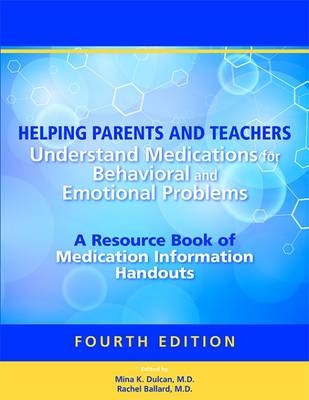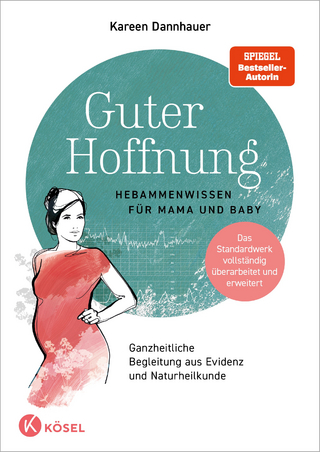
Helping Parents and Teachers Understand Medications for Behavioral and Emotional Problems
American Psychiatric Association Publishing (Verlag)
978-1-58562-506-2 (ISBN)
A dozen experts in child and adolescent psychiatry contributed to this new and fully updated fourth edition of Helping Parents and Teachers Understand Medications for Behavioral and Emotional Problems, ensuring that it remains the most trusted resource for educating parents and teachers about psychotropics prescribed for children and adolescents. The book is arranged alphabetically, and each medication has its own information sheet that can be photocopied or downloaded and printed by psychiatrists, pediatricians, and neurologists for distribution to parents and teachers.
A useful resource for school staff and library patrons, the information sheets will also be helpful to nonprescribing mental health professionals talking with families about possible referral for medication.
The compendium has been designed for maximum utility and accessibility.
• Each information sheet includes a section with general information applicable to all medications and very specific sections that include a description of the medication and why it is used, monitoring of the medication, side effects, interactions with other medications and with food, and additional information that is relevant to how the medication can best help and be used safely.
• The book is written in a straightforward, understandable style that is accessible and nonintimidating to the lay public.
• The number of medications covered has been expanded to reflect new drugs and older drugs recently approved for children and adolescents, such as vilazodone (Viibryd), asenapine (Saphris), and ramelteon (Rozerem).
• Explanations of new concerns about potential side effects and FDA black box warnings for antidepressants and stimulants are included.
• The "Information on the Internet" section offers a list of vetted medical and professional organizations where the reader can find additional information about child and adolescent mental health and treatment, and the book also includes robust lists of both published resources for parents and teachers and selected additional reading for health and mental health professionals.
• Appendices cover medicines with FDA indication for attention-deficit/hyperactivity disorder (ADHD); medicines typically used for anxiety, depression, psychosis, mood stabilizing, and aggression; and an index of medicines by brand name.
No other volume offers up-to-the-minute information on psychotropic medications for youth in such an easy-to-use format. Comprehensive and authoritative, Helping Parents and Teachers Understand Medications for Behavioral and Emotional Problems will prove indispensable to clinicians in helping to foster understanding among parents and educators.
Mina K. Dulcan, M.D., is Head of Child and Adolescent Psychiatry at Ann & Robert H. Lurie Children's Hospital of Chicago; and Professor of Psychiatry and Behavioral Sciences and Pediatrics at Northwestern University Feinberg School of Medicine in Chicago, Illinois. Rachel R. Ballard, M.D., is Attending Physician (Child and Adolescent) at Ann & Robert H. Lurie Children's Hospital of Chicago; and Assistant Professor of Psychiatry and Behavioral Sciences and Pediatrics at Northwestern University Feinberg School of Medicine in Chicago, Illinois.
Introduction forcClinicians to the fourth edition. Selected additional reading for health and mental health professionals. Publishedresources for parents and teachers. Information on the internet. Online Access. Alprazolam—Xanax, Intensol, Niravam. Amitryptiline—Elavil. Amphetamine—Dexedrine, DextroStat, Adderall, Adderall XR, ProCentra, Vyvanse. Aripiprazole—Abilify. Asenapine—Saphris. Atenolol—Tenormin. Atomoxetine—Strattera. Benzodiazepines Used for Sleep: Temazepam—Restoril; Estazolam—ProSom; Flurazepam—Dalmane; Triazolam—Halcion. Benztropine—Cogentin. Bupropion—Wellbutrin, Budeprion, Aplenzin. Buspirone—BuSpar. Carbamazepine—Tegretol, Tegretol XR, Carbatrol, Epitol, Equetro. Chlorpromazine—Thorazine. Citalopram—Celexa. Clomipramine—Anafranil. Clonazepam—Klonopin. Clonidine—Catapres, Kapvay. Clozapine—Clozaril, FazaClo, Versacloz . Cyproheptadine—Periactin. Desipramine—Norpramin. Desmopressin Acetate—DDAVP, Stimate. Diazepam—Valium. Diphenhydramine—Benadryl. Duloxetine—Cymbalta. Escitalopram—Lexapro. Fluoxetine—Prozac. Fluphenazine—Prolixin. Fluvoxamine—Luvox. Gabapentin—Neurontin, Gralise. Guanfacine—Tenex, Intuniv. Haloperidol—Haldol, Haldol Decanoate. Hydroxyzine—Atarax, Vistaril. Hypnotics: Nonbenzodiazepines: Zolpidem—Ambien, Ambien-CR, Edluar, Intermezzo; Eszopiclone—Lunesta; Zaleplon—Sonata. Iloperidone—Fanapt. Imipramine—Tofranil. Lamotrigine—Lamictal. Levomilnacipran—Fetzima. Lithium—Eskalith, Lithobid. L-methylfolate—Deplin. Lorazepam—Ativan. Loxapine—Loxitane, Adasuve. Lurasidone—Latuda. Melatonin. Metformin—Glucophage, Glucophage XR, Glumetza, Fortamet, Riomet. Methylphenidate—Methylin, Ritalin, Metadate, Concerta, Daytrana, Focalin, Quillivant. Mirtazapine—Remeron. Modafinil—Provigil /Armodafinil—Nuvigil. N-acetylcysteine. Nortriptyline—Pamelor. Olanzapine—Zyprexa. Omega-3 Fatty Acids. Oxcarbazepine—Trileptal, Oxtellar XR. Paliperidone—Invega. Paroxetine—Paxil, Pexeva. Perphenazine—Trilafon. Pimozide—Orap. Pindolol . Prazosin—Minipress. Propranolol—Inderal. Quetiapine—Seroquel. Ramelteon—Rozerem. Risperidone—Risperdal. Sertraline—Zoloft. Sodium Oxybate—Xyrem. Thiothixene—Navane. Topiramate—Topamax, Topiragen, Trokendi XR. Trazodone—Oleptro. Trifluoperazine—Stelazine. Valproic Acid—Depakene/Divalproex Sodium—Depakote. Venlafaxine—Effexor/Desvenlafaxine—Pristiq, Khedezla. Vilazodone—Viibryd. Vorioxetine—Brintellix. Ziprasidone—Geodon. Appendix 1: Medicines with FDA Indication for Attention- Deficit/Hyperactivity Disorder. Appendix 2: Medicines Typically Used for Anxiety and Depression. Appendix 3: Medicines Typically Used for Psychosis. Appendix 4: Medicines Typically Used for Mood Stabilization or Reducing Aggression. Index of Medicines by Brand Name.
| Erscheint lt. Verlag | 19.5.2015 |
|---|---|
| Zusatzinfo | Not illustrated |
| Verlagsort | VA |
| Sprache | englisch |
| Maße | 216 x 279 mm |
| Gewicht | 1302 g |
| Themenwelt | Sachbuch/Ratgeber ► Gesundheit / Leben / Psychologie ► Schwangerschaft / Geburt |
| Medizin / Pharmazie ► Medizinische Fachgebiete ► Pädiatrie | |
| Medizin / Pharmazie ► Medizinische Fachgebiete ► Pharmakologie / Pharmakotherapie | |
| Medizin / Pharmazie ► Medizinische Fachgebiete ► Psychiatrie / Psychotherapie | |
| Sozialwissenschaften ► Pädagogik ► Sonder-, Heil- und Förderpädagogik | |
| ISBN-10 | 1-58562-506-X / 158562506X |
| ISBN-13 | 978-1-58562-506-2 / 9781585625062 |
| Zustand | Neuware |
| Haben Sie eine Frage zum Produkt? |
aus dem Bereich


